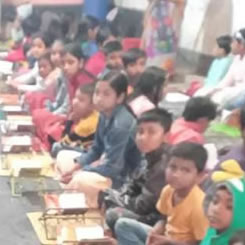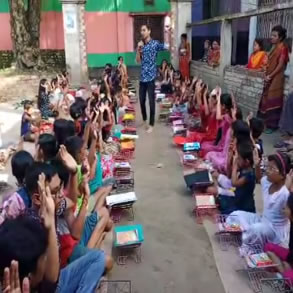Bhagavad Gita Schools In Bangladesh
- David Burgess
- Apr 1
- 9 min read
Key Takeaways
Bhagavad Gita schools in Bangladesh focus on instilling spiritual values and pride among students, emphasizing the spiritual teachings of the Bhagavad Gita.
These schools operate primarily serve as informal centers for Vedic education, offering lessons in scriptures and ethical living.
The curriculum includes not only religious texts but also subjects that equip students with the ability to engage in discussions about their faith confidently.
Despite facing societal and resource challenges, these schools play a critical role in preserving Vedic culture and traditions in a Muslim-majority country.
There is potential for growth and expansion of these schools with increased community support and involvement.
A Bhagavada Gita Class In Session
Introduction to Bhagavad Gita Schools in Bangladesh
In the heart of Bangladesh, where the Hindu population is a minority, a unique form of education is thriving. Bhagavad Gita schools offer a spiritual oasis for young minds eager to explore the rich tapestry of Vedic teachings. These schools are not just about learning verses from the Bhagavad Gita; they are about cultivating a sense of identity and pride in one's heritage.
These educational centers function primarily on Fridays and Saturdays, the weekly holidays in Bangladesh. They serve as informal hubs where children gather to learn about their faith in a supportive environment. Here, the timeless wisdom of the Bhagavad Gita is more than just a text; it is a guide for living a life of purpose and virtue.
Background of Vedic Education in Bangladesh
Vedic refers to the earliest period of Indian history and culture, specifically related to the ancient sacred texts known as the Vedas. Here's what it encompasses:
The Vedas: Four ancient Sanskrit texts (Rigveda, Samaveda, Yajurveda, and Atharvaveda) that form the oldest layer of Sanskrit literature and the earliest Hindu scriptures.
Time period: Generally refers to the period from approximately 1500 BCE to 500 BCE, though scholars debate the exact timeframe.
Language: Vedic Sanskrit, an archaic form of Sanskrit that evolved into Classical Sanskrit.
Religion: The early form of Hinduism practiced during this period, characterized by ritual sacrifices (yajna), worship of natural forces as deities, and the prominence of priests (brahmins).
Philosophy: Early philosophical concepts found in the later portions of the Vedas, especially the Upanishads, which explore metaphysical questions about the nature of reality, consciousness, and the self.
The term "Vedic" is often used as an adjective to describe things related to this period or these texts, such as Vedic mathematics, Vedic astrology, or Vedic chanting.
The roots of Vedic education in Bangladesh trace back to a time when the region was part of the greater Indian subcontinent. Over the years, the socio-political landscape has shifted dramatically, influencing the educational opportunities available to Hindu communities.
Despite these changes, the desire to preserve cultural and religious teachings has remained strong.
In recent years, organizations like Lotus Ministry Trust have taken steps to establish Vedic schools across the country. These schools aim to provide a robust foundation in Vedic scriptures, ensuring that the younger generation grows up with a deep understanding of their faith.
Purpose and Mission of the Schools
The primary mission of Bhagavad Gita schools is to nurture a sense of spiritual identity among Hindu children. By teaching the Bhagavad Gita and other Vedic texts, these schools aim to instill values such as honesty, compassion, and respect. The goal is to prepare students not only for academic success but also for a life guided by ethical principles.
Moreover, these schools play a vital role in fostering a sense of community among families. They provide a space where students can connect with peers who share their beliefs, creating a supportive network that extends beyond the classroom. This community aspect is crucial in a country where Hindus are a minority, as it helps reinforce cultural identity and pride.
Curriculum and Educational Approach
The educational approach in Bhagavad Gita schools is holistic, integrating spiritual teachings with practical life skills. The curriculum is designed to be engaging and relevant, ensuring that students can apply what they learn in their daily lives.
Core Subjects and Topics
A Bhagavad Gita Student Reciting
At the heart of the curriculum are the teachings of the Bhagavad Gita. Students learn to recite verses and understand their meanings, delving into the philosophical concepts that underpin Vedic thought.
Besides religious texts, the curriculum also includes subjects that help students develop critical thinking and communication skills. This well-rounded approach ensures that students are equipped to engage in meaningful discussions about their faith and articulate their beliefs confidently.
The Role of the Bhagavad Gita in Education
The Bhagavad Gita serves as a cornerstone of the educational experience in these schools. Its teachings on duty, righteousness, and devotion are woven into the fabric of the curriculum, providing students with a moral compass to guide their actions.
Through the study of the Bhagavad Gita, students learn to navigate the complexities of life with wisdom and grace. They are encouraged to reflect on their personal experiences and draw connections between the teachings of the Gita and their own lives. This reflective practice helps students internalize the lessons and apply them in practical ways.
Integration of Values and Ethics
In addition to academic subjects, Bhagavad Gita schools place a strong emphasis on character development. Students are taught the importance of values such as honesty, integrity, and respect for others. These lessons are reinforced through stories, discussions, and activities that encourage students to practice these values in their interactions with others. For more information, you can visit Bhagavad Gita School's Facebook page.
By integrating values and ethics into the curriculum, these schools aim to cultivate well-rounded individuals who are not only knowledgeable about their faith but also committed to living by its principles. This holistic approach to education is key to inspiring spiritual growth in students and preparing them for a life of purpose and fulfillment.
Impact and Significance of Bhagavad Gita Schools
Bhagavad Gita schools hold a unique position in Bangladesh's educational landscape. They provide a vital platform for the transmission of Vedic spiritual and cultural values in a predominantly Muslim society. The significance of these schools extends beyond mere education; they are instrumental in shaping the identity and worldview of young Hindu students.
Cultural and Spiritual Influence on Students
These schools serve as cultural sanctuaries where students can immerse themselves in their rich heritage. The teachings of the Bhagavad Gita offer profound insights into life and spirituality, encouraging students to explore their inner selves and understand their place in the world. This spiritual education fosters a sense of peace and purpose, guiding students through life's challenges with resilience and wisdom.
Moreover, the schools provide a sense of belonging and community. In a country where Hindu culture is not the majority, these institutions offer a safe space for students to express their beliefs and traditions. This environment nurtures confidence and pride in one's heritage, which is crucial for personal development and self-esteem.
Through regular engagement with spiritual texts, students learn to appreciate the timeless wisdom of their ancestors. This exposure not only enriches their understanding of Vedic philosophy but also strengthens their connection to their cultural roots. The spiritual influence of these schools is profound, helping students develop a holistic worldview that integrates ethical living with spiritual growth.
Role in Preserving Vedic Traditions
In a rapidly changing world, the preservation of cultural traditions is essential. Bhagavad Gita schools play a crucial role in this endeavor by keeping the teachings of the Vedas alive for future generations. They ensure that students are well-versed in rituals, customs, and practices that define Vedic culture.
The schools also emphasize the importance of festivals and ceremonies, encouraging students to participate in these cultural events. This active involvement helps students understand the significance of these traditions and fosters a sense of continuity and connection with their heritage. By preserving these practices, the schools contribute to the cultural richness and diversity of Bangladesh.
Challenges Faced by Bhagavad Gita Schools
Despite their positive impact, Bhagavad Gita schools face several challenges that threaten their sustainability and growth. These challenges are multifaceted, ranging from societal pressures to resource constraints.
Societal and Demographic Challenges
Operating in a Muslim-majority country presents unique challenges for Bhagavad Gita schools. Societal perceptions and biases can sometimes create obstacles for these institutions.
Additionally, demographic shifts and urbanization have led to changes in community structures, affecting the enrollment and operation of these schools.
Resource and Funding Limitations
Funding is a significant challenge for many Bhagavad Gita schools. As informal educational centers, they often rely on donations and community support to sustain their operations. This reliance can lead to financial instability, affecting the quality and reach of the education they provide.
Furthermore, limited resources can impact the availability of qualified teachers and educational materials. Schools may struggle to maintain infrastructure and provide students with the necessary tools for learning. These limitations underscore the need for increased support and investment to ensure the long-term viability of these institutions.
Future Prospects and Opportunities

A Lotus Ministry Trust Bhagavad Gita Class
Despite the challenges, there are promising opportunities for Bhagavad Gita schools to expand and thrive. With strategic planning and community involvement, these schools can continue to make a meaningful impact on the lives of Bhagavad Gita students in Bangladesh.
One potential avenue for growth is the establishment of partnerships with local and international organizations. These collaborations can provide additional resources and support, helping schools overcome financial and operational hurdles. Additionally, leveraging technology can enhance educational delivery and broaden the reach of these institutions.
Community engagement is another critical factor in the future success of Bhagavad Gita schools. By fostering strong relationships with local communities, schools can build a network of support that sustains their mission and enhances their impact. Encouraging alumni involvement and volunteerism can also strengthen the schools' foundation and ensure their continued relevance.
Explore partnerships with organizations for funding and resources.
Incorporate technology to enhance educational delivery.
Strengthen community ties to build a robust support network.
Encourage alumni involvement to sustain the schools' mission.
Potential for Growth and Expansion
There is significant potential for Bhagavad Gita schools to expand their reach and influence. By increasing awareness and understanding of their mission, these schools can attract more students and supporters. Efforts to promote the schools' successes and contributions to society can help garner wider recognition and support.
Moreover, by adapting to changing educational needs and incorporating innovative teaching methods, Bhagavad Gita schools can remain relevant and appealing to new generations of students. This adaptability will be key to their continued growth and success in the years to come.
Community Support and Involvement
Community support is crucial for the sustainability and success of Bhagavad Gita schools. These institutions thrive on the active involvement of parents, alumni, and local community members who contribute their time, resources, and expertise. By fostering a strong sense of community, schools can create an environment where students feel supported and valued.
To enhance community involvement, schools can organize events and workshops that encourage participation from all stakeholders. These events provide opportunities for community members to engage with the school's mission and contribute to its growth.
Additionally, fostering open communication between the school and the community can help build trust and collaboration, ensuring that the school's needs and goals align with those of the community.
Frequently Asked Questions
Many people have questions about Bhagavad Gita schools and their role in education. Here, I address some of the most common inquiries to provide clarity and insight into these unique institutions.
What is the main focus of Bhagavad Gita schools?
Instilling Vedic values and spiritual teachings in students.
Providing a supportive environment for cultural and religious education.
Fostering a sense of community and identity among students.
These schools aim to nurture well-rounded individuals who are knowledgeable about their faith and equipped to navigate the complexities of life with wisdom and integrity.
The emphasis is on teaching the principles of the Bhagavad Gita and other Vedic texts, ensuring that students develop a strong moral and ethical foundation.
How do these schools differ from regular schools?
Bhagavad Gita schools differ from regular schools primarily in their focus on spiritual and cultural education.
Are these schools officially recognized by the government?
As informal educational centers, Bhagavad Gita schools may not always have official recognition from the government. However, they play a crucial role in supplementing the education of students by providing spiritual and cultural teachings that are not typically covered in regular schools.
Despite the lack of formal recognition, these schools are highly valued by the communities they serve and are supported by various Hindu organizations and community members.
How is the Bhagavad Gita integrated into the curriculum?
The Bhagavad Gita is central to the curriculum in these schools. Students learn to recite and interpret verses, exploring the philosophical and ethical teachings contained within the text.
Lessons are designed to help students apply these teachings to their daily lives, fostering a deeper understanding of their faith and its relevance to modern life.
What are the benefits of attending a Bhagavad Gita school?
Attending a Bhagavad Gita school offers numerous benefits for students. They gain a strong foundation in Vedic teachings and values, which can guide their personal and spiritual development. These schools also provide a supportive community where students can connect with peers who share their beliefs and cultural heritage.
Moreover, the emphasis on ethical living and spiritual growth helps students develop important life skills, such as critical thinking, empathy, and resilience. These skills are invaluable as students navigate the challenges of life and work towards becoming responsible, compassionate individuals.













Comments